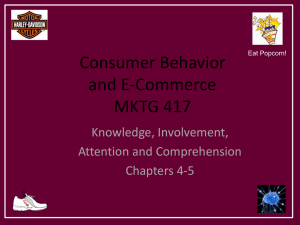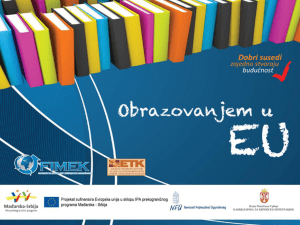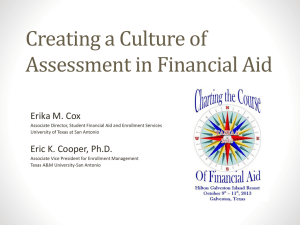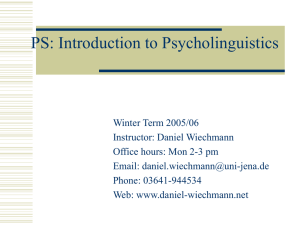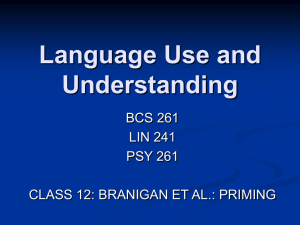“The Psychological Consequences of Money” Vohs, K.D., Mead
advertisement
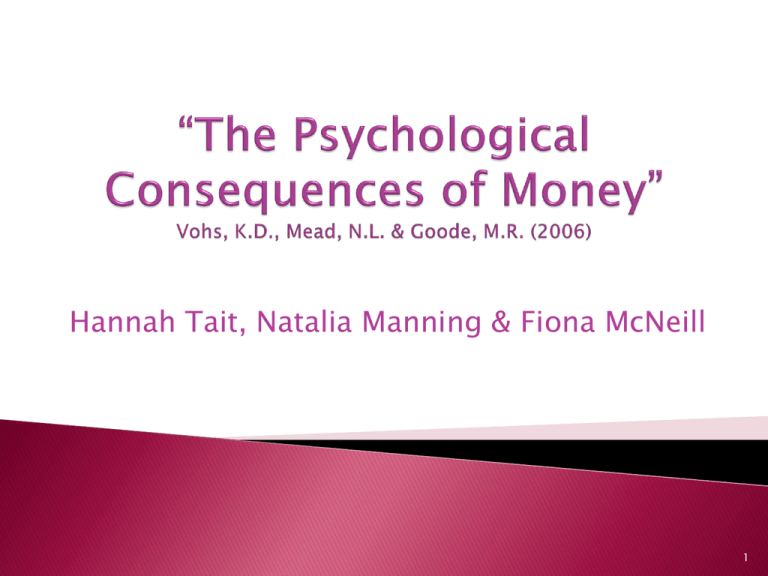
Hannah Tait, Natalia Manning & Fiona McNeill 1 Foundations: Money = incentive (Lea & Webley, 2006) Money undermines interpersonal harmony (Amato & Rogers, 1997) Are both right? Are both a result of selfsufficiency? Self Sufficiency ◦ Being free from needing others to effectively perform a task ◦ Socially insensitive: others can also do it themselves 2 Investigated idea that money brings about a self-sufficient orientation 9 experiments IV = Money priming techniques Money priming led to reduced desire for help and reduced helpfulness towards others. 3 Exp. N 1 52 Conditions Priming method 3 Descramble/Monopoly money DV Time taken to ask for help Sig. level p<0.02, p<0.03 Prediction: Participants primed with money would work longer than controls before requesting help Participants primed with real money, play money or neutral concepts Participants were given difficult but solvable problems Money primed participants (real or play) worked longer than those primes with neutral concepts. 4 5 But did the experimenter’s perceived status influence the participant’s behaviour?.... 6 Exp. N 2 38 Conditions Priming method 2 Essay DV Time taken to ask for help Sig. level p=0.05 Prediction: Participants primed with high money would spend more time working than participants primed with low money before asking for help Status differences between the participant and experimenter were removed High money primed participants spent longer on the task than low money primed participants 7 8 Exp. N 3 39 Conditions Priming method 2 Descramble DV Sig. level Time volunteered to help experimenter p<0.05 Prediction: People who value self-sufficiency will be less helpful than others because they expect each person to take care of themselves Participants were primed with either money or neutral concepts Money primed participants offered less help than neutral concept primed participants 9 But as the experimenter asked for help in the future did money primed participants fail to realise that help was truly needed?…. 10 Exp. 4 N 44 Condi -tions Priming method 2 Descramble DV Time spent helping a peer Sig. level p<0.04 Prediction: Participants primed with money would spend less time helping than controls Participants joined by a confederate completing another task who pretended not to understand their task instructions Money primed participants spent just 45% of the time helping that controls spent 11 But did participants perceive that helping the confederate required previous knowledge?…. 12 Exp. 5 N 36 Condi -tions Priming method 3 Monopoly money, Imagine DV Sig. level Number of pencils gathered p<0.02, p<0.05 Prediction: Participants primed with money would offer less help than controls Primed in 2 steps: 1. Played Monopoly with a confederate. Left with play money of differing amounts. 2. Imagine a future with abundant finances (high money), strained finances (low money) or imagine plans for tomorrow (control) Confederate spilled a box of pencils High money condition picked up an average of 2 less than control condition (difference not as large for low money condition). 13 Exp. N 6 44 Condi -tions Priming method 2 Descramble DV Value of monetary donation Sig. level p<0.05 Prediction: participants primed with money concepts would donate less money $2 in quarters in exchange for participation Filler questionnaires and a false debrief Experimenter mentioned they were taking donations in a box by the door Mean for controls was 57₡ (74%) more than for money primed participants 14 Exp. N 7 36 Condi -tions Priming method 3 Screensavers DV Physical distance from partner Sig. level P<0.05, p<0.05 Tested in social context using physical distance Questionnaires in front of computer screen Screensaver: currency/fish/blank screen “Get acquainted” conversation – asked to move chairs Money prime: places chairs further apart Physical distance 15 16 Exp. N 8 61 Condi -tions Priming method 3 Posters DV Number of solitary activities chosen Sig. level P<0.05, p<0.05 Tested in social context Questionnaire with poster on wall in front of them Currency/seascape/flower garden Second questionnaire: choose between solo activity or an activity for two or more people Money prime: individually focused leisure experiences Less social 17 18 Exp. N 9 37 Condi -tions Priming method 3 Screensavers DV Choice whether to work alone or in a pair Sig. level P<0.05, p<0.05 Tested in working context Used the same screensaver conditions as Exp. 7 (Money/Fish/None) Project work – alone or with peer? Money prime: less likely to choose to work with peer 19 Exp. N Condi -tions Priming method DV Sig. level 1 52 3 Descramble/Monopoly money Time taken to ask for help p<0.02, p<0.03 2 38 2 Essay Time taken to ask for help p=0.05 3 39 2 Descramble Time volunteered to help experimenter p<0.05 4 44 2 Descramble Time spent helping a peer p<0.04 5 36 3 Monopoly money, Imagine Number of pencils gathered p<0.02, p<0.05 6 44 2 Descramble Value of monetary donation p<0.05 7 36 3 Screensavers Physical distance from partner P<0.05, p<0.05 8 61 3 Posters Number of solitary activities chosen P<0.05, p<0.05 9 37 3 Screensavers Choice whether to work alone or in a pair P<0.05, p<0.05 20 Hypothesis supported- money brings about a state of self-sufficiency Predictions met – money primes cause you to be less helpful towards others and more inclined to work alone Implications- enhanced individualism but diminished communal motivations in today's money focused society 21 Previous research has not looked at this directly First to focus on self-sufficiency Many of the experiments are not original (Macrae et al. 1994; Twenge et al., 2007) but not necessarily unimproved Questions the issue in a real world setting Builds on its own foundations, experiments become more rigorous often improving on the last 22 The 2 aspects of ‘self-sufficient’ defined are investigated Design focuses on real life behaviour But… Experiment 7: distance chair is placed from partner – does this fit with the definition of self-sufficient? Experiment 8: options for group vs. independent social activity – does this really fit with the definition of self-sufficient given? 23 Filler questionnaires and false debriefs Blind-to-condition experimenters/confederates (where possible) Double-check system Controlled for mood fluctuations Checked for and excluded suspicious participants No systematic errors identified but less of a concern as tasks don’t produce specific values to be applied We are surprised more people were not suspicious Selection bias: participants were all students from the US and Canada 24 An extensive array of experiments Findings were consistent throughout But… Is money making you more self-sufficient or Stubborn Hard working Antisocial 2 way system of money and self-sufficiency (Zhou, Vohs & Baumeister, 2009) 25 Increasing salary may make you work harder ◦ But can increasing salary decrease employees prosociability? (Jordan, 2010) Money impairs people’s everyday abilities to savour everyday positive emotions and experiences (Quoidbach et al. 2010) Willingness to volunteer own time is affected by thinking of time in terms of money (Pfeffer & DeVoe, 2009). 26 Student population not representative Although students are from Canada, the US, China and Hong Kong they are all at one of 3 universities in North America Between subjects design Does the experiment really apply to longterm real life? 27 Test in a country that values social networks more and individualism less e.g. Japan Test using people of differing socioeconomic status Longitudinal within subjects study 28 We question that the hypothesis has been supported: A salient concept of money appears to increase self-sufficient behaviour… but is it really self-sufficient? Thorough and well designed experiment Very consistent (significant) findings Easily applicable to a real world setting But… 2 experiments do not conclusively show self sufficiency 29 Vohs, K.D., Mead, N.L. & Goode, M.R. (2008). Merely Activating the Concept of Money Changes Personal and Interpersonal Behaviour, Current Directions in Psychological Science, 17(3), 208212. 30 Vohs, K.D., Mead, N.L. & Goode, M.R. (2006) The Psychological Consequences of Money. Science, 314, 11541156. www.sciencemag.org/cgi/content/full/314/5802/1154/DC1 31 1. 2. 3. 4. 5. 6. 7. 8. Amato, P.R. & Rogers, S.J. (1997) A longitudinal study of Martial Problems and Subsequent Divorce. Journal of Marriage and Family, 59(3), 612-624. Jordan, J.M. (2010) Salary and Decision Making: Relationship Between Pay and Focus on Financial Profitability and Prosociability in an Organizational Context. Journal of Applied Social Psychology, 40(2), 402-420. Lea, S. E. G. & Webley, P. (2006) Money as tool, money as drug: The biological psychology of a strong incentive.Behavioural and Brain Sciences, 29, 161209. Macrae, C.N., Bodenhausen, G.V., Milne, A.B. & Jetten, J. (1994) Out of mind but back in sight: stereotypes on the rebound, Journal of Personality and Social Psychology, 67, 808-817. Pfeffer, J. & DeVoe, S.E. (2009) Economic evaluation: The effect of money and economics on attitudes about volunteering. Journal of Economic Psychology, 30(3), 500-508. Twenge, J.M., Baumeister, R.F., DeWall, C.M. Ciarocco, N.J. & Bartells, J.M (2007) Social Exclusion Decreases Prosocial Behaviour. Journal of Personality and Social Psychology, 92(1), 56-66. Quoidbach, J., Dunn, E.W., Petrides, K.V. & Mikolajczak, M. (2010) Money Giveth, Money Taketh Away, Psychological Science, 21(6), 759-763. Zhou, X.Y., Vohs, K. D. & Baumeister, R. (2009). The symbolic power of money: Reminders of money alter social distress and physical pain. Psychological Science, 20, 700–706. 32
